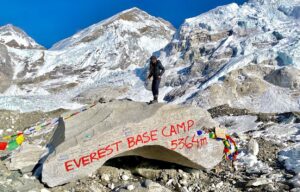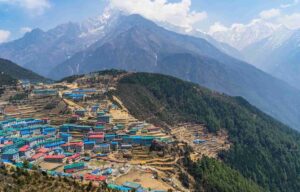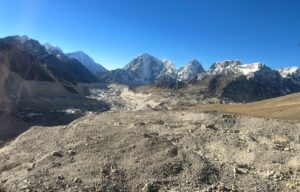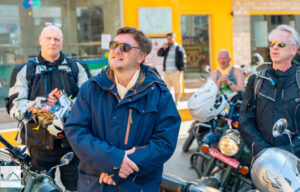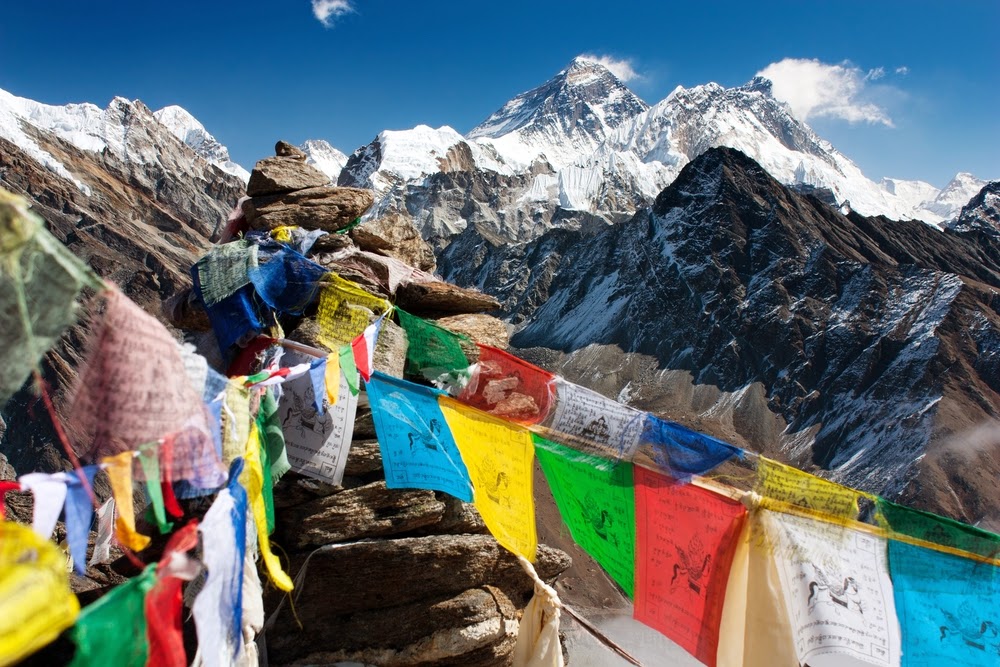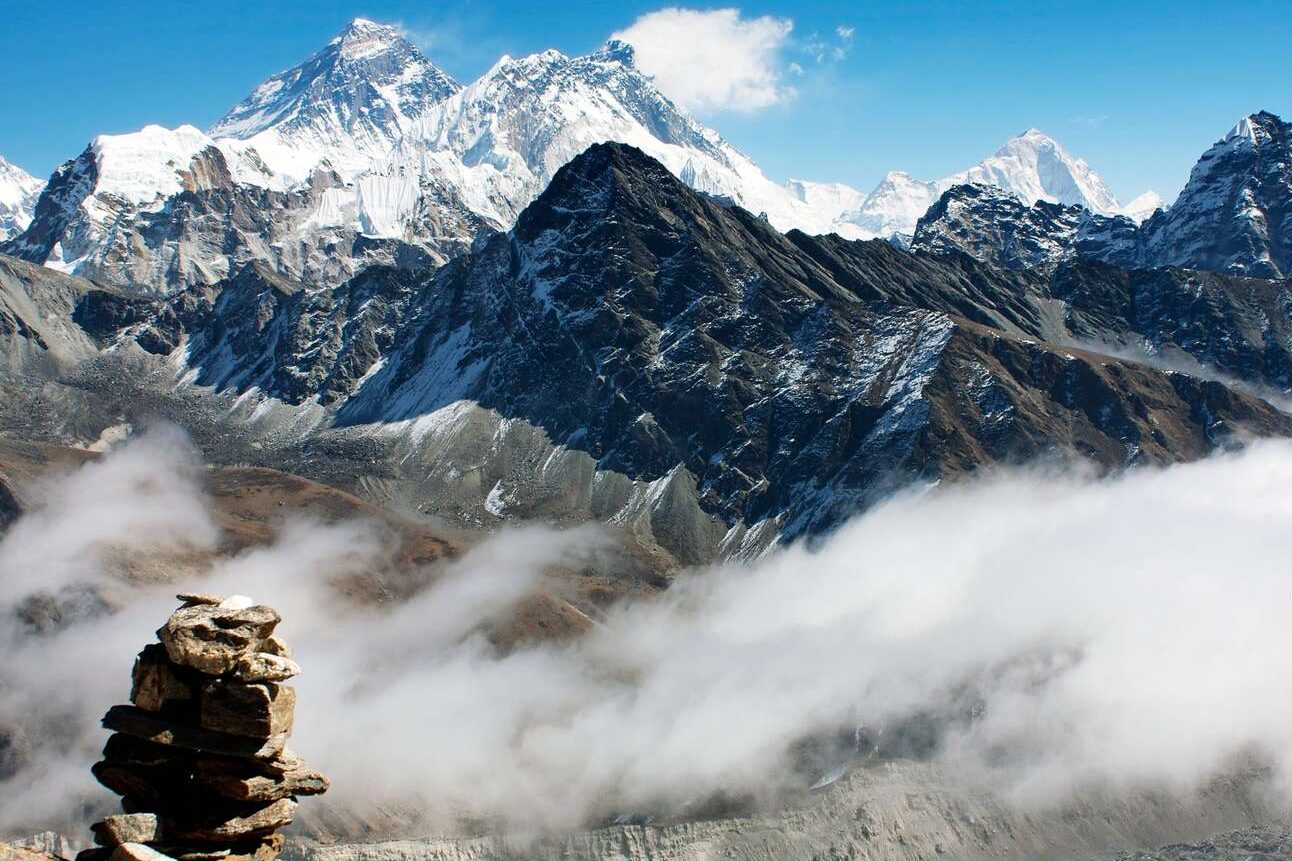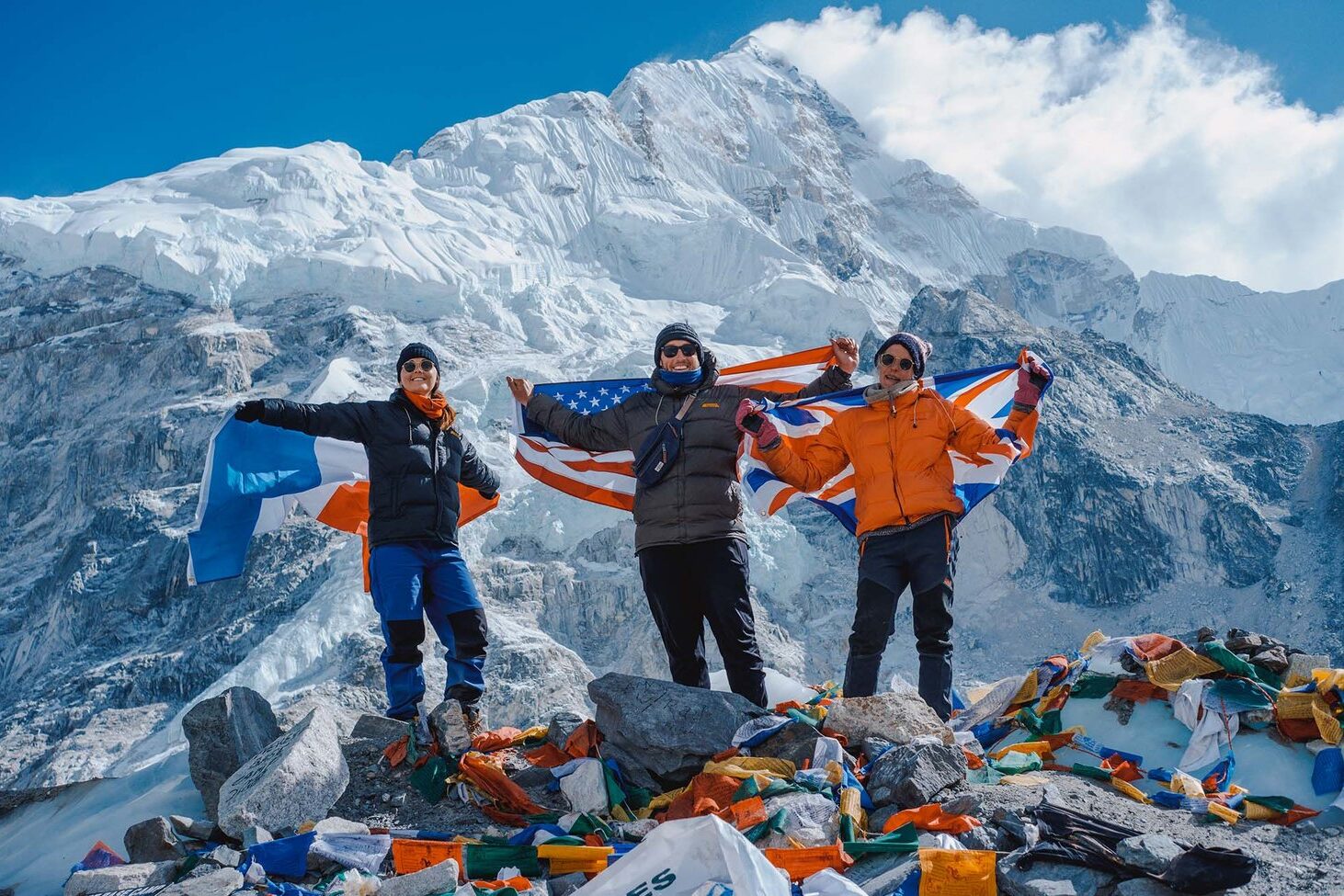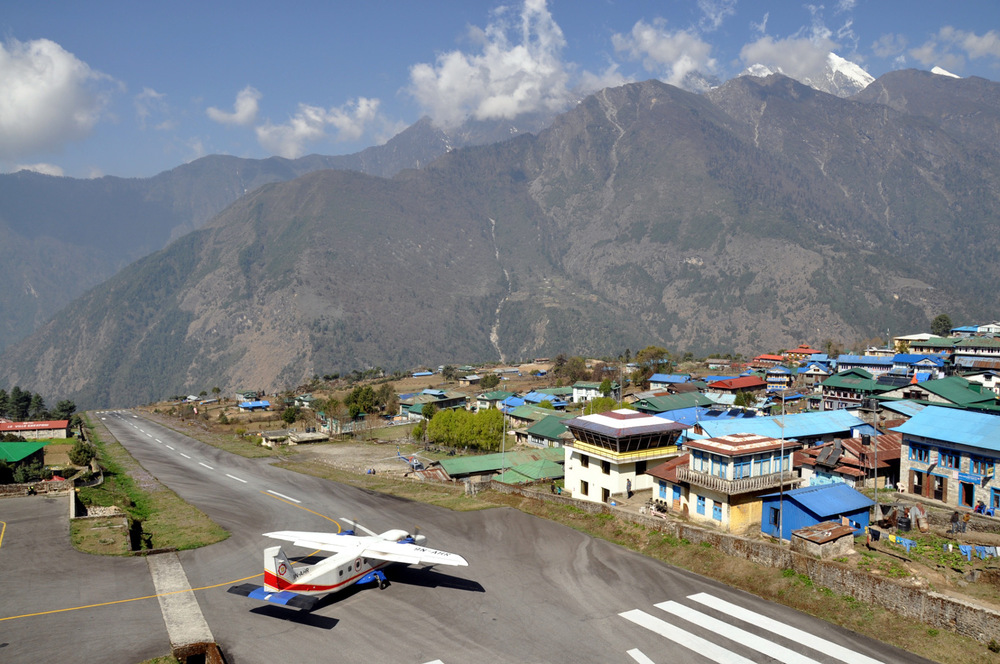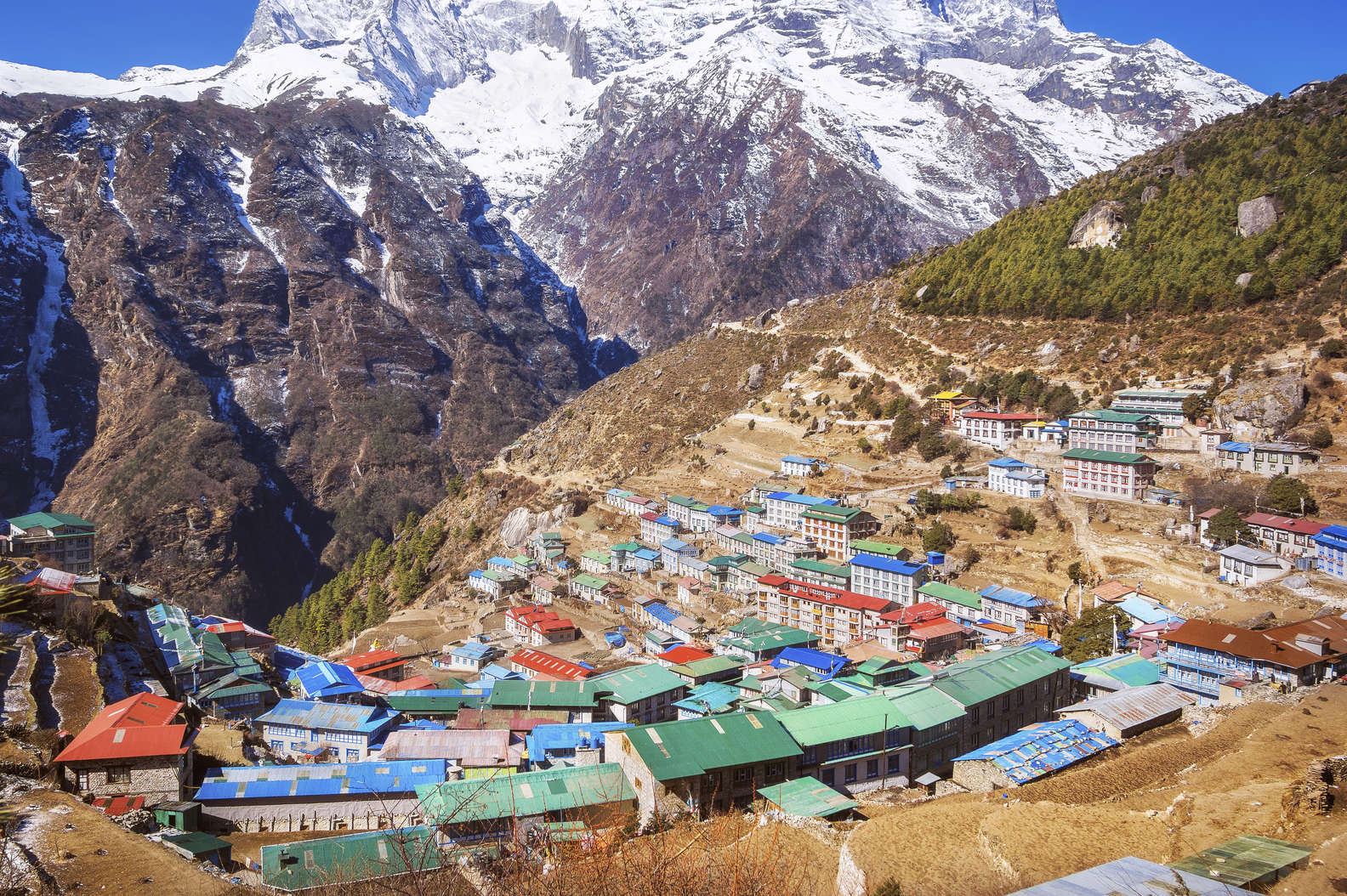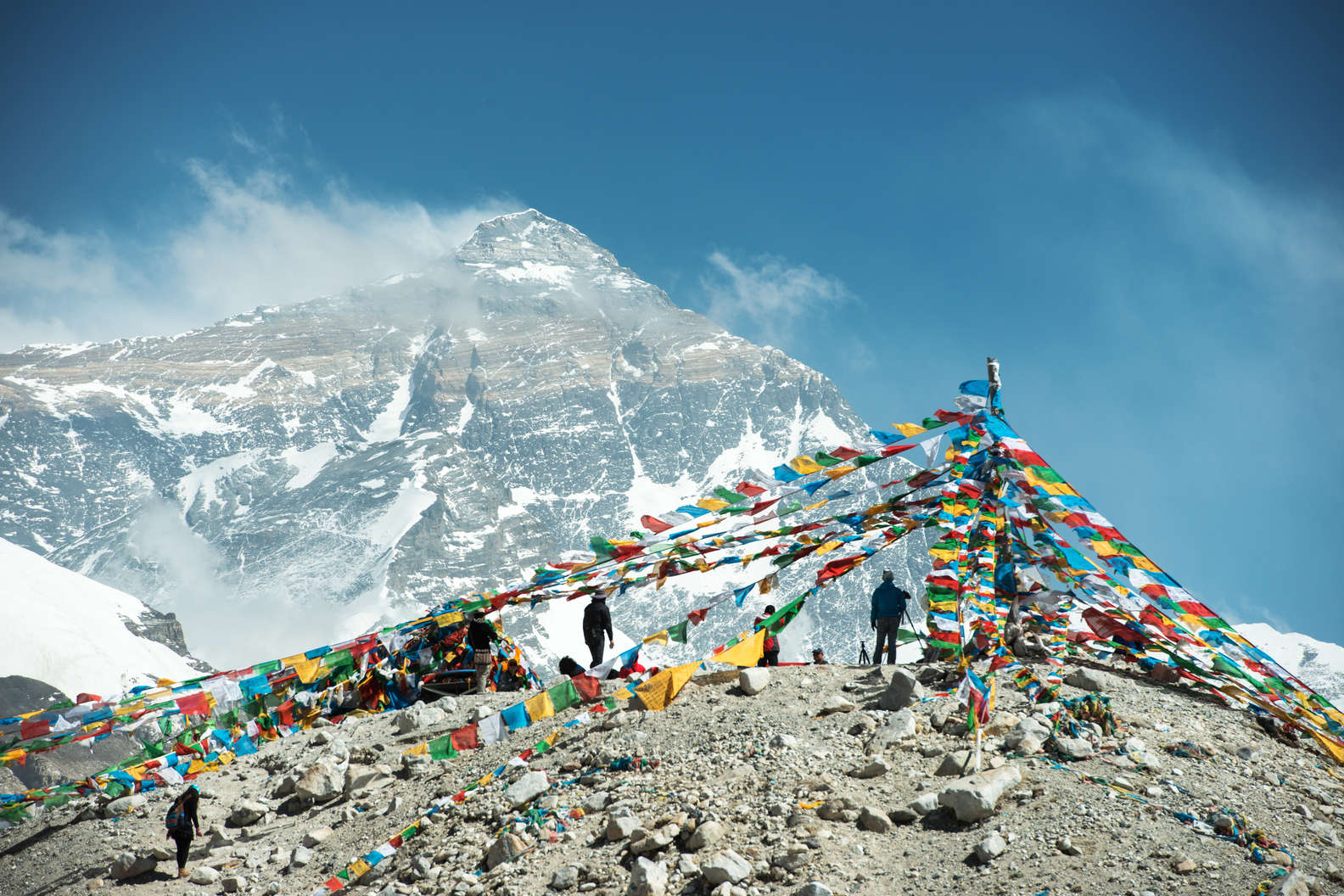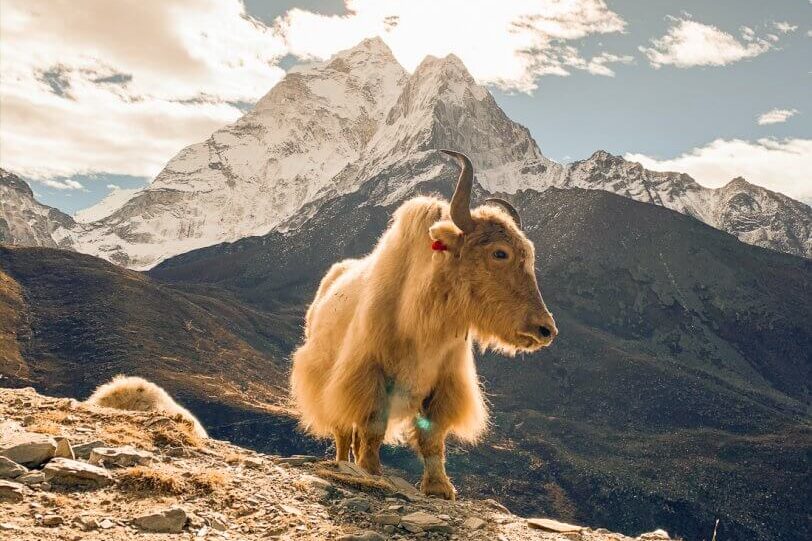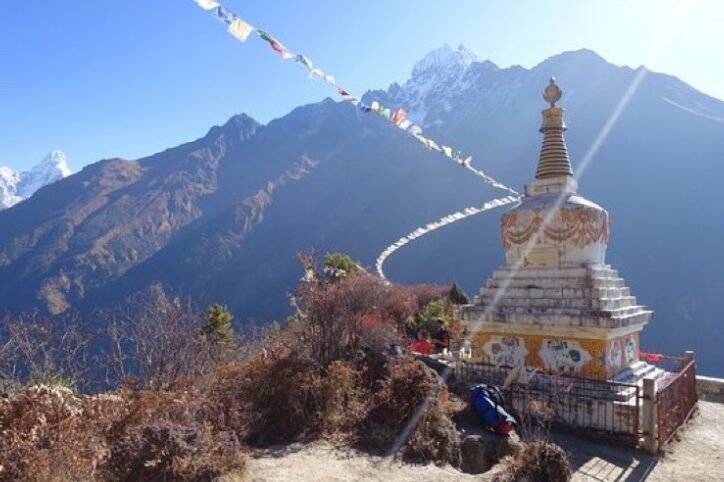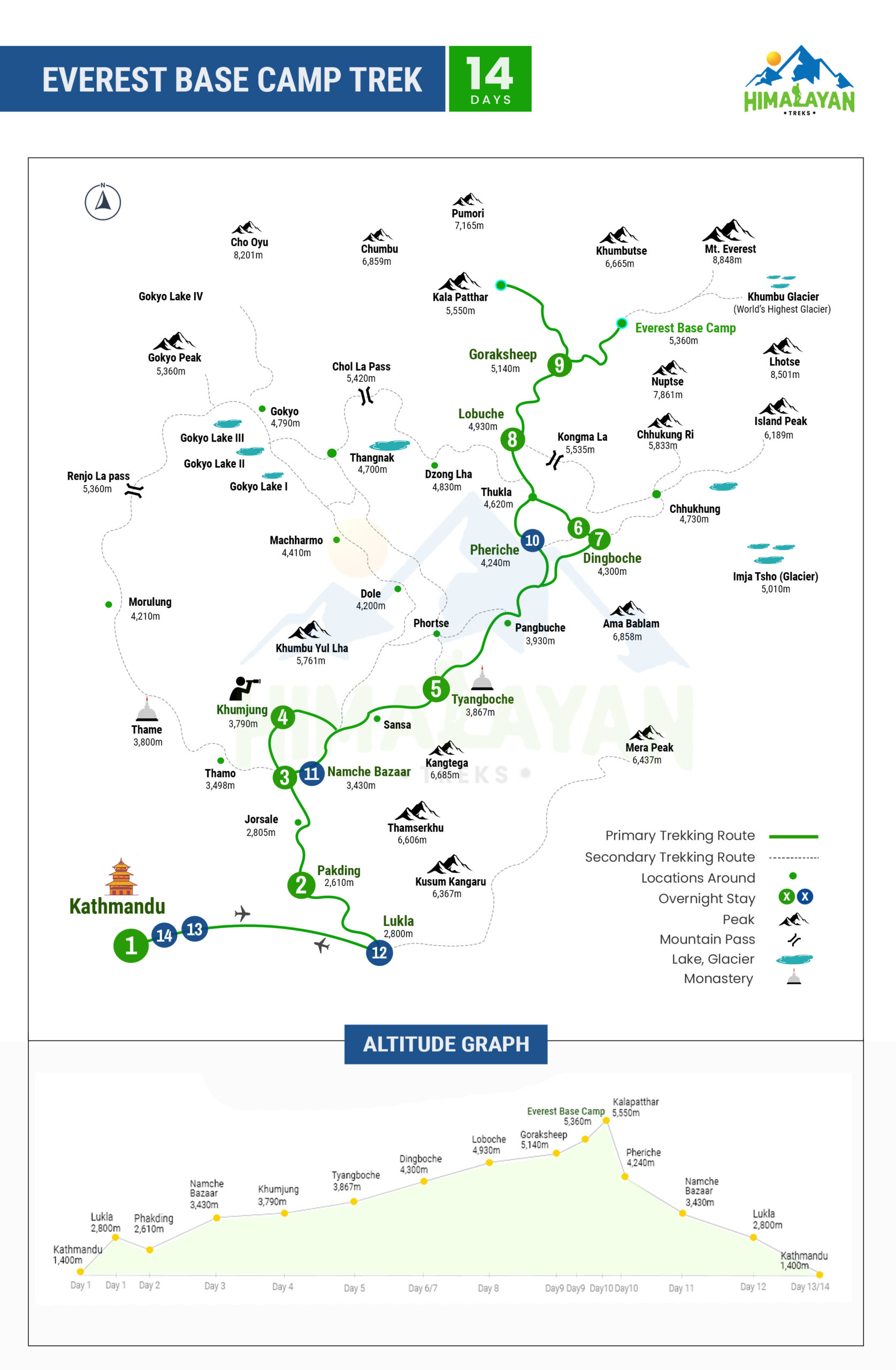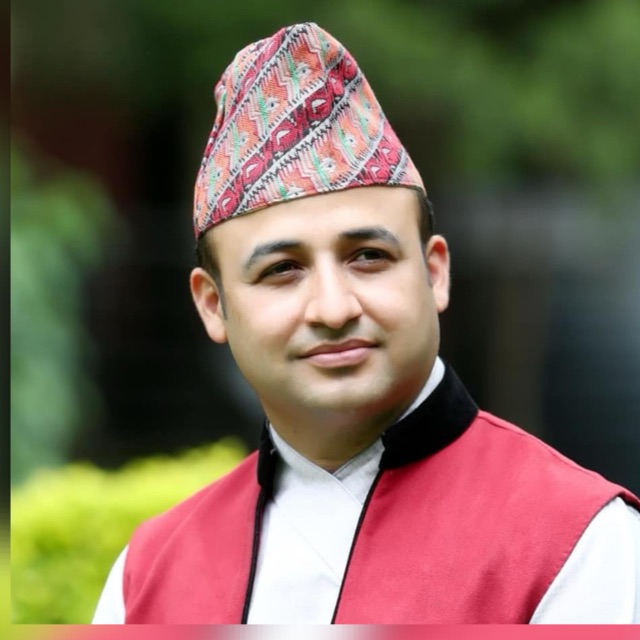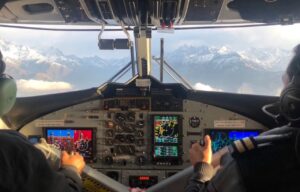Some of the most beautiful views on the EBC Trek
People love the Everest Base Camp (EBC) Trek because of its beautiful scenery and wide views of the Himalayas. Still, some vantage points stand out because they offer truly amazing views that will leave you speechless. Here are some of the most beautiful sights you’ll see on your EBC trek:
- Namche Bazaar, the starting point for climbing Mount Everest.
Imagine walking through a lively village in the Himalayas that is surrounded by tall mountains and full of people going about their daily lives. This is Namche Bazaar, also known as the “Gateway to Everest,” and it is the first big stop on your EBC journey.
The Namche Bazaar is an experience in and of itself. It’s a place to rest, recharge, and get ready for the next journey. So, take your time when you visit this lively village. Enjoy the atmosphere and make memories that will last a lifetime. Famous peaks like Mount Everest, Lhotse, Ama Dablam, and Nuptse can be seen from this spot.
- Tengboche Monastery is a spiritual haven that is 3,867 meters above sea level.
Tengboche is a must-see on your Everest Base Camp Trek. It is a peaceful place to be in the middle of the Himalayas’ grandeur.
Let’s say you’re tired after a long day of hiking, but the fresh mountain air makes you feel good. As you walk up the steps to the monastery, the sound of monks singing and prayer flags flapping greets you.
Tengboche Monastery is on a hilltop in the Khumbu Valley with a view of the Himalayas. It is more than just a sacred building; it shows what the Sherpa people are really like.
- At 5,545 meters above sea level, Kala Patthar is almost as high as Everest.
In Nepali, “Kala Patthar” means “black rock,” but that doesn’t give you a sense of how lonely or harsh this view is. In fact, Kala Patthar is a very different experience.
Imagine standing on a windy ridge and looking out at Mount Everest, which is right there. That’s Kala Patthar, a rocky peak that gives you the best view of the world’s biggest mountain without actually climbing it. This “black rock” will fill your heart with the beauty of the Himalayas and the desire to go on a journey. However, getting to this place is not that simple.
How to Get to Everest Base Camp in 14 Days
Day 1-3:
You took a plane from Kathmandu to Lukla and began your trek through pine woods and Sherpa villages. Warm up in Namche Bazaar, which is the entrance to Everest.
Day 4–7:
Cross the famous Tengboche Bridge, see the Tengboche Monastery, and walk along glacial rivers and yak farms.
Day 8–10:
Get to Gorakshep, which is the last stop before base camp. From Kala Patthar, the highest point of the trip, you can see the sunrise over Everest and Lhotse.
Day 11–14:
Make your way back to Lukla, taking in the changing views and thinking about what you’ve done.
This is just a quick outline; the actual route may be different based on things like the weather. Check out the schedule for a better idea of the 14-day EBC trek plan.
Why to Pick The Himalayan Treks for Everest Base Camp Trekking?
At Himalayan Adventure Treks, we’re more than just a trekking company—we’re your dedicated companions on your journey to Everest Base Camp. Here’s why we are the ideal choice for your EBC adventure:
Your Success, Our Goal:
We understand how meaningful it is for you to reach Everest Base Camp, and we are dedicated to making that journey a reality.
We tailor your EBC experience to go above and beyond what you expect.
Your safety and well-being are our top priorities. We maintain a comprehensive backup plan to handle any unforeseen situations, ensuring you can trek with confidence.
Journey of Fun and Serious Adventure:
We mix the difficulty of EBC with fun and interesting stories from the area.We think the excitement is in the trip itself.
Local experts’ guides and must-haves:
Our skilled guides and porters are fluent in English and bring extensive knowledge of Everest Base Camp to enrich your experience.
We provide essential trekking gear, including sleeping bags, down clothing, an oximeter, and a first-aid kit, ensuring you’re fully equipped for the journey.
You can focus entirely on the trek while we handle all logistics, ensuring a seamless, stress-free adventure from start to finish.
Value, freedom, and peace of mind:
We have reasonable prices and deals that you can count on. We’re happy to take last-minute reservations and cancellations.
Flexible Itineraries: You can pick from itineraries that have already been made or have them changed to fit your fitness level and hobbies.
Come with us to Everest Base Camp and see what a difference it makes to choose a partner over just a trekking company.
Best time to Trek to Mt Everest Base Camp
You’re ready to start the famous Everest Base Camp hike, but you don’t know when to do it. You don’t have to worry—this guide will help you find the best time for your EBC challenge based on the seasons.
Spring (March–May)
The best time of year overall. The best parts are the clear skies, stable weather, and beautiful views.
This is the busiest time of year for people who want to hike to Everest Base Camp. Think of sunny days, clear skies, and mountain views that will make you speechless. There’s a good chance you’ll see the famous sunrise over Lhotse and Everest.
Fall (September to November)
Highlights: nice weather, fewer people, and beautiful scenery Another popular time to go walking is when the weather is nice and the trails are easy to navigate. There will be fewer people on the trails, and you can see the Himalayas’ beautiful fall colors.
Summer (June to August)
The best parts are the beautiful wildflowers, the lush scenery, and the monsoon rain. This time of year is truly unique, with lush vegetation and blooming wildflowers making for a stunning setting for your hike. However, be ready for monsoon rain, which can sometimes close trails or cause delays.
Winter (December to February)
Off-season adventure, one-of-a-kind experience, and fewer people Winter can be difficult and fun for people who like to take risks. You can expect scenery covered in snow and fewer people, which will make you feel alone and excited.
Yes, each season has its own “Wild Side.”
It’s important to remember that the right month or season for you will depend on your own tastes. When making your choice, you should think about things like your physical and mental health, the weather, the number of people there, your budget, and the view you want.
There are beautiful times of the year and difficult times, but let’s be honest: the monsoon season (June–August) can make even the most experienced trekker laugh out loud.
Trekkers might not call seasons “bad,” though. Instead, they might call them “bonus challenges” that need a little more planning and toughness.
During the monsoon season at EBC, the area is a lush green paradise, with wildflowers popping up everywhere. However, the tracks become muddy, and it rains unexpectedly, making you want to pull out your hair. Not everyone should go on this crazy trip!
How Hard is it to Hike to Everest Base Camp?
While Everest Base Camp trekking may sound like a tough task, many people can reach it with enough planning and a sense of adventure! Here is a list of what to look forward to on this trip:
Altitude: The high altitude, which at Everest Base Camp is over 5,500 meters, is the hardest thing. It can have many effects on your body, like making you short of breath or having a headache. With a moderate ascending plan and rest days, we will help you get used to the altitude so that these effects are lessened.
Trails: There will be well-kept trails, rougher roads with rocks and steps, and even some suspension bridges. For extra support and steadiness, we’ll give you strong trekking poles.
Weather: Get ready for all sorts of weather, from clear blue skies to cold temperatures and even snow. We’ll give you a full list of what you need to stay warm and dry during the trip.
To beat EBC, you need to have strong leg muscles and a strong heart. The best way to get ready is to do a lot of exercise, especially running or climbing. Don’t worry if you don’t work out very often—the important thing is steady training, not amazing strength!
Why should You Book a Trek to EBC – 14-day Package?
The 14-day package perfectly balances challenging trekking, acclimatizing to altitude, and an immersive experience. Opting for this Everest Base Camp trekking package for 14 days is the ideal choice for most tourists due to the following:
- Gradual ascent and acclimatization to the altitude.
Commencing at lower elevations and progressively ascending each day, the 14-day package facilitates a gradual ascent, minimizing the risk of altitude sickness and allowing your body to acclimatize to the thinner air. Ample time is allocated for adapting to the altitude, providing opportunities to rest and explore key locations such as Namche Bazaar (3,440 m) and Dingboche (4,410 m). These acclimatization days prepare your body for the final stretch to Everest Base Camp.
- Achieving an optimal blend of enjoyment and challenge.
The 14-day itinerary offers a fantastic balance. Featuring both challenging treks, such as the Khumbu Glacier ridge and Kala Patthar, and rejuvenating rest days with stunning views from locations like Tengboche Monastery and Namche Bazaar, this plan provides a well-rounded experience. Striking this balance ensures a continuous and fulfilling exploration of the rich culture and natural beauty of the Everest region.
- Complete cultural immersion and community support are integral aspects of the 14-day package.
Ample time is allocated to connect with the hospitable Sherpa community, allowing you to visit their towns, understand their customs, and receive warm welcomes. By choosing a reputable trekking company with local guides, you actively contribute to the welfare of the Sherpa community and promote environmentally conscious travel.
- Choice and flexibility
While the 14-day deal serves as an excellent starting point, it can be tailored to meet your specific preferences. Whether you choose to skip Kala Patthar or extend your stay in Namche Bazaar, customization is flexible and achievable. This flexibility ensures that your trekking experience aligns perfectly with your interests and fitness level. Ultimately, the 14-day package stands out as the optimal choice for hikers seeking a secure, enjoyable, and educational journey to Everest Base Camp—an adventure that will undoubtedly leave an indelible mark on your memory!
Everyday Life at Everest Base Camp Trek
There is always something exciting going on with the EBC Trek. This is how most days go in the Everest region.
Fuel your body for the upcoming ascent with a hearty breakfast. As you hit the trail, expect a varied terrain, featuring rugged paths, suspension bridges, and routes frequented by yak herders. The landscape continually transforms, transitioning from lush woods to rocky valleys framed by glaciers. At every turn, a fresh, picturesque view unfolds, creating a visual journey filled with captivating scenes.
Around midday, indulge in a straightforward lunch typically savored at a teahouse en route. Energize yourself with nourishing options such as soups, noodles, and local snacks like dal bhat. Teahouses have become a daily gathering spot for hikers, offering a setting to share stories and relish the scenic views from the windows.
In the afternoon, the pace slows down as you approach your daily destination. Depending on the altitude, you may have leisure time to explore the town, visit a monastery, or simply relax and admire the scenery. During acclimatization days, engage in shorter hikes or walks to nearby lookout points, aiding your body in adapting to the reduced oxygen levels.
In the evening, you’ll settle into your inviting teahouse room just as the sun begins its descent, casting long shadows across the valleys. Amidst a sky adorned with stars, sharing stories and laughter with fellow adventurers becomes a truly enchanting experience.
Every day on the EBC trek is different, with a different mix of physical challenges, learning about the culture, and beautiful views. It’s a trip that will test your limits, make you strong, and give you experiences that will last a lifetime.
What to Eat and Drink?
Dal Bhat: traditional dish made of lentils and rice.
Momos: steamed or fried dumplings that are a popular snack.
Yak butter tea: salty tea that is mixed with yak butter.
Local barley beer from Chyang is served in teahouses.
Chhaam: A yogurt drink that’s great on hot days.
Safety and Health on the EBC Trek
Embarking on the Everest Base Camp Trek ventures into high altitudes, demanding careful consideration of your health and safety. Ensure the altitude and unforeseen circumstances do not disrupt your journey. Here’s a comprehensive guide covering everything you need to confidently navigate the Everest Base Camp trekking:
How to Treat Altitude Sickness?
As you ascend, oxygen levels decrease, putting strain on your body and potentially leading to altitude sickness if you ascend too quickly. Recognizing abnormal sensations such as headaches, nausea, dizziness, fatigue, elevated heart rate, and sleep disturbances is crucial. Ignoring these signs can have serious consequences.
Adhering to our gradual ascent plan, allowing time for acclimatization, is essential. Listen to your body; rest when needed, avoid pushing yourself excessively, and allow your body to adapt.
Stay hydrated, even if you don’t feel thirsty, as dehydration exacerbates mountain sickness. If symptoms persist, descend promptly. Descending aids in recovery and prevents further complications.
How to Stay Safe and Some Tips ?
Demonstrate respect for the mountains by adhering to designated paths, avoiding unnecessary risks, and staying mindful of unpredictable weather changes. Maintain constant communication with your guides, informing them of your plans and ensuring you have a means of emergency contact. In wooded areas, tranquility of mind is paramount.
Be prepared for varying weather conditions by packing appropriate clothing, sturdy boots for rough terrain, and sunscreen for intense sun exposure. Prioritize safety and adaptability to fully enjoy your mountain experience.
Prioritize your health and safety to ensure a seamless and unforgettable EBC trek. As mentioned earlier, our responsibility is to keep you secure and in good health throughout the journey.
Attend to your well-being, adhere to guidelines, and place trust in your guide. The Himalayas await your exploration. With proper preparation, you can ascend confidently, returning home with enduring experiences that will stay with you for a lifetime.
Getting ready for the Everest Base Camp Trek
To ascend Sagarmatha, being in both physical and mental peak condition is imperative, as mentioned in the section on fitness requirements. Refer to the following list for more specific and comprehensive preparations to ready yourself for the exhilarating Everest Base Camp trek:
- Stamina Building Through Walking:
Initiate with brief walks, progressively increasing both distance and intensity. Work towards engaging in longer walks on varied terrain, such as hills or uneven paths, to simulate trekking conditions.
- Cardiovascular Exercises for Heart Health:
Incorporate heart-healthy exercises like swimming, jogging, or cycling to enhance the strength of your heart and lungs. This boosts the stamina essential for extended hikes.
- Strengthening Core and Leg Muscles:
Include exercises targeting your core (such as planks and sit-ups) and leg muscles (like squats and lunges). Strengthening these areas is crucial for providing support during the trek.
- Gradual Progression:
Initiate your workout regimen well in advance, gradually escalating the duration and intensity of your sessions. This gradual approach minimizes the risk of injuries while promoting overall fitness.
- Seek Guidance from a Fitness professional.
Consult with a fitness expert or trainer to devise a workout plan aligned with your health and fitness level. Monitor your progress and make adjustments as necessary.
- Mental preparedness:
In addition to physical readiness, emotionally prepare for the trek by maintaining a positive mindset, embracing setbacks, and cultivating the resilience needed to overcome the challenges of the journey.
Views of Nature
Experience breathtaking panoramas of Everest, Lhotse, and other towering Himalayan peaks, set against the backdrop of lush valleys, charming Sherpa towns, and serene monasteries.
Marvel at the awe-inspiring vistas of Everest and surrounding peaks, complemented by equally stunning sights of remote high-altitude passes, glacial lakes, and quaint Tibetan towns.
Solo Trek to Everest Base Camp
The Everest Base Camp Trek is typically undertaken in a group setting, but recognizing that some individuals prefer a more solitary and personal experience, a solo EBC trek could be suitable, particularly for seasoned hikers seeking the ultimate challenge and self-discovery.
Important Note: The solo EBC trekking is not included in our standard group packages due to the potential for unforeseen events. However, if you are still interested, please contact us, and we will guide you through the following steps:
Tailored Itinerary and Logistics: Crafting a customized plan aligns with your altitude acclimatization, personal interests, and preferred pace.
Facilitation of Local Trekking Permits and Arrangements: Handling the necessary paperwork to ensure you possess all the required licenses for your solo trek.
Accommodation and Porter Options: Connecting you with reliable guesthouses and experienced porters who understand the unique needs of solo hikers.
Safety Training and Emergency Support: Providing comprehensive safety training and immediate assistance in case of emergencies, with round-the-clock availability, 24/7.
Contact us to discuss your solo EBC trek adventure if you’re confident in your skills and up for the challenge. We can assist you in creating plans for your unique journey to the base of the world’s tallest mountain.
- Booking and Logistics
- The Booking Procedure
Things to Remember Before Trekking EBC with The Himalayan Treks
We’re thrilled to accompany you on this significant trek! To confirm your place in our carefully curated EBC Trek package, simply follow these straightforward steps:
- Choose Your Preferred Dates: Review our available departure times and select the one that suits your schedule.
- Contact Us: Reach out to our helpful team after finalizing your preferred dates. We’re here to address any queries, discuss your preferences, and confirm availability.
- Secure Your Reservation: To confirm your spot, a reservation fee is required. This can be easily done through our secure online payment platform or by transferring funds to our designated bank account.
- Complete the Booking Process: We will provide a straightforward booking form for you to fill out, including personal and trip details. This ensures that your trek aligns with your preferences and requirements.
- Prepare for Your Journey: Upon confirmation of your reservation, we will send you a comprehensive pre-departure information pack. This includes a detailed itinerary, a packing list, safety guidelines, and essential cultural information.
- Anticipate the Adventure: Be confident that your EBC journey is well-managed in our hands. We take care of all the planning, permits, and logistics. Channel your focus into your Everest Base Camp training, pack your excitement, and get ready for the adventure of a lifetime.
We can’t wait to show you the way to the top of the world!
Planning a Trip
Getting to Kathmandu
- Flights: Tribhuvan International Airport in Kathmandu is serviced by numerous international airlines. Plan your flights in advance, especially during peak travel times.
- Visa: Most visitors from other countries require a visa to enter Nepal. You can apply online or at the Nepalese embassy or consulate in your home country.
- Travel Insurance: We strongly recommend comprehensive travel insurance covering medical emergencies, trip cancellations, and evacuation.
Flight from Kathmandu to Lukla
- Scenic Adventure: The 40-minute flight to Lukla, the starting point for Everest Base Camp treks, offers breathtaking views, making it an adventure in itself.
- Weather Considerations: Lukla airport is weather-dependent, so be prepared for possible delays and exercise patience.
Accommodation and Dining
- Tea Houses and Lodges: Along the EBC trail, cozy guesthouses (tea houses) provide basic amenities and serve delicious local cuisine.
- Dietary Preferences: Inform us of any dietary restrictions, and we’ll ensure suitable food options for you.
Licenses and Forms
- Permits: We will assist in obtaining necessary permits, including a trekkers’ permit and a TIMS (Trekkers’ Information Management System) card.
- National Park Fees: Entrance fees are required for Sagarmatha National Park.
Transport and Porters:
- Trail Walking: The trek primarily involves walking, offering stunning views at every step.
- Porter Options: Consider hiring a porter if uncertain about your fitness level.
- Helicopter Evacuation: Emergency helicopter evacuation insurance is advisable, and we can help you obtain coverage if needed.
Communication:
- Limited Wi-Fi: Expect limited internet connectivity during the trek, providing a break from technology.
- Cell Phone Coverage: Some areas have cell phone service, but it may not be reliable.
Essentials:
- Pack Light: Be mindful of what you bring; refer to our comprehensive packing list for necessary items.
- High-Altitude Acclimatization: Take it slow, ascend gradually, and pay attention to your body.
- Cultural Awareness: Dress modestly, respect religious sites, and learn basic Nepali phrases to show consideration for the local people.
What to Bring for the Everest Base Camp Trekking?
Equipment List for the Everest Base Camp Trek in Nepal:
Luggage/Duffle Bag:
- A duffel bag or backpack (65-75 L) for trekking, carried by porters. Provided by Himalayan Adventure if needed.
Day Backpack:
- A day backpack (at least 25 Liter) for personal daily use, carrying essentials like passport, credit card, water bottle, snacks, and clothing layers.
Trekking/Hiking Boots:
- Sturdy, waterproof trekking boots for challenging terrain. Ensure a proper fit and comfort during walking. Consider bringing crampons in winter.
Sport Sandals:
- A pair of sports shoes or sandals for use in camps or tea houses after the trek.
Sneakers:
- Not suitable for the Everest Base Camp trek. Can be left at the Kathmandu hotel until return.
Sleeping Bag:
- Lightweight sleeping bag suitable for minus 20 degrees in summer and minus 25 degrees in winter. Provided by Himalayan Adventure if needed (to be returned after the trek).
Fleece Jacket:
- At least one high-quality fleece jacket or pullover for warmth during trekking.
Down Jacket:
- A compulsory warm down jacket for the Everest Base Camp trek. Socks:
- At least 5 pairs of thick socks for spring and autumn, and at least 7 pairs for winter and monsoon.
Lightweight/Warm Insulated Pants:
- Three pairs of lightweight trekking pants suitable for various weather conditions.
Short-Sleeved Shirts:
- Three ice-breaker merino wool or synthetic shirts for warmth. Long-Sleeved Shirts:
- At least three long-sleeved shirts.
Underwear:
- Sufficient pairs of underwear due to limited washing facilities on the trek.
Waterproof Jacket:
- At least one waterproof jacket and optional waterproof pants for rain, snow, and wind.
Head and Face Gear:
- Sun hat or cap, woolen hat for mornings and evenings, and polarized sunglasses.
Hand Gear:
Traveling Supplies:
- Adapter plug, camera belt, passport belt (optional), Swiss army knife (optional), flashlight, headlamp, water bottle, extra camera battery, hand sanitizer, alarm clock, hiking poles (optional), binoculars (optional).
Toiletries:
- Razor, razor blades, shaving cream, aftershave, toothbrush, toothpaste, dental floss, sunscreen, toilet paper, small towel, and period pads (for women).
Medication:
- First Aid Medical Kit (available in Thamel, Kathmandu), Altitude Medicines (Diamox), Tylenol, aspirin, ibuprofen, anti-diarrheic, powerful antibiotics, nasal spray, or drops.
Tips for Everest Base Camp Trek in Nepal
Acclimatize Like a Pro: Begin your ascent gradually, stay hydrated, pay attention to your body, and adopt the “climb high, sleep low” mantra for effective acclimatization.
Layer Up and Protect Your Feet: Pack warm clothing layers and ensure sturdy hiking boots to ward off blisters – a potential summit spoiler.
Sun & Rain Prep: Arm yourself with sunscreen and a hat for sun protection, and carry a reliable raincoat to handle unexpected showers.
Embrace the Sherpa Spirit: Learn a few Nepali phrases, respect local customs, and embrace the warmth of the Sherpa community – their camaraderie will fuel your journey.
Leave No Trace: Practice responsible tourism by carrying out all your trash, leaving the mountains pristine for future adventurers.
Savor the Moments: Capture memories through photographs, immerse yourself in the stunning scenery, and cherish every moment of this unforgettable journey.
Conclusion
Our 14-day Everest Base Camp Trek is more than just a journey; it’s an experience that stays with you forever. From the moment you set foot on the trail, you’ll be surrounded by stunning landscapes, welcomed by the rich Sherpa culture, and supported by our dedicated team. We’ve designed this trek to balance challenge with enjoyment, allowing you to take in each unforgettable moment—from the majestic views of Kala Patthar to the peaceful vibes at Tengboche Monastery.
With our flexible approach, we ensure your trek aligns with your pace and interests. Whether it’s pausing longer in Namche Bazaar or capturing a sunrise at Everest’s foothills, we’re here to make it happen. Join us on this extraordinary adventure to Everest Base Camp, where every step brings you closer to the heart of the Himalayas and leaves you with memories that will inspire you long after you’ve returned home.
Remember, safety and enjoyment are our top priorities. Let’s conquer Everest Base Camp together!
Are you ready for the most thrilling journey of your life? Book your Everest Base Camp trek -14 Days package today!
